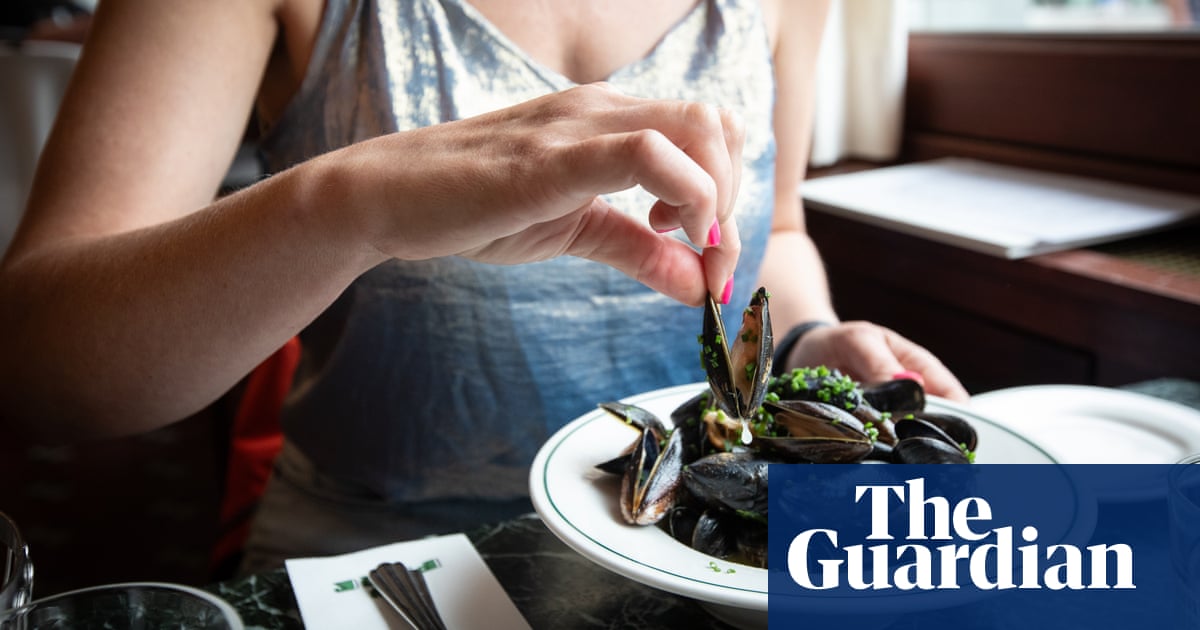It is harvest day at the Westdiep sea farm and the crew are bringing their haul on to the boat: 12-metre long ropes laden with clusters of blue mussels. Bobbing on the water just three nautical miles off the Belgian coast, the four-man crew on the little red Smart Farmer use a crane to hoist the ropes on deck. The mussels go on to a steel conveyor belt, straight into the “declumper”, a machine that will break up bunches of molluscs into smaller groups.
It may look like a typical late summer scene on the Belgian North Sea coast, but the mussel harvest is a novelty. Although Belgium is renowned for its moules frites, it has long struggled to cultivate the shellfish for its national dish on a commercial scale. Of the estimated 20,000 tonnes of mussels Belgium consumes each year, most are imported from Zeeland in the Netherlands.
For years, mussels in Belgium’s waters ended up on the sea floor. “We have a really straight shoreline, so we don’t have sheltered areas and that has really limited the possibilities for cultivating mussels,” says Loren Timmermans, Westdiep’s project manager, who was involved in building the farm.
But now Belgian supermarket group Colruyt has successfully harvested the homegrown mussels after a decade of research, and hopes to collect 50 tonnes of mussels this year, up from six tonnes in 2023, the first harvest.
“We have the perfect sea to farm mussels,” says Stijn Van Hoestenberghe, operational manager of the sea farm. “You need to have the combination of boats, the biology and the geography, and that’s what we have here. [The North Sea] is not very deep, so at low tide it’s only 12 to 13 metres deep.”
Above all the North Sea offers nutrient-rich waters that are perfect for the abundant, naturally occurring mussel seed (young mussels). “There are a lot of nutrients in the water, a lot of plankton because of the sediment here,” Van Hoestenberghe says. “Biologically, it’s fantastic.”
Spread as far as the eye can see, orange and yellow buoys are bobbing on the gently rolling waves. Mussels are growing on looped undersea ropes – made from recycled fishing nets – suspended from long lines held together by the buoys and anchors. So far Westdiep is using only a fraction of its 1 sq km area, about 40 lines. The farm is hoping to produce annually up to 2,000 tonnes of mussels when all 600 potential lines are being used. Experts consider this optimistic, forecasting a more modest 1,300 tonnes.
Competing with the Netherlands is “not the goal”, Timmermans says. “It is to create a new Belgian product.”
Ordering moules in many Belgian restaurants means a kilo of shellfish served in a large black pot, with a generous portion of frites and mayonnaise on the side. According to the Flemish food historian Regula Ysewijn, mussels were being served in humble eateries in the late-19th century, but really took off as Belgian cuisine after the 1910 Brussels World Fair, when the still young nation was “constructing a culinary identity”.
The Westdiep farm was launched after years of near misses and some short-lived successes. In the 2000s, one firm succeeded in cultivating mussels in cages, but the sea farm closed down after the equipment was damaged in a storm. “The cages were not strong enough so they sank to the bottom,” says Daan Delbare, head of aquaculture at the Institute for Agriculture, Fisheries and Food, an independent research body backed by the Flemish government.
There was a failed experiment to grow mussels between wind turbines, while a notion to attach cages to the side of piers never got off the drawing board. Delbare, who was involved in the research for North Sea long lines, but does not work for Colruyt, says the rope system will prove more durable. “We developed a long line that is working with the sea, so it is flexible and doesn’t break so quickly as the cages.”
This year’s harvest season runs from June to September, making the most of calmer seas, although in future it is likely to extend into the autumn as more lines are used. Conditions are rarely perfect, however, and the Smart Farmer might see only 20 fine days a year.
There are plenty of rough days. Sometimes, when the wind is forcing the boat away from the ropes, the work is precarious. “If the tension gets too much, [the ropes] can snap, or the crane can break, and then you realise, OK, we have to stop now, because things get too difficult,” Van Hoestenberghe says, stressing the importance of safety at sea.
Connoisseurs say Belgian mussels have a particular taste, reflecting the blend of North Sea nutrients they feast on during their 18-month growing period. Strong currents carrying plentiful nourishment mean Belgian mussels grow more quickly and become plumper than those grown in calmer waters, experts say.
“They really have the taste of the sea, but very delicate, slightly salty and very soft … like a praline,” says Shannah Zeebroek, manager of the Café du Parc, an elegant art-deco brasserie in nearby Ostend, one of only 15 restaurants serving the Westdiep mussels, which are also sold in four of Colruyt’s upmarket outlets.
At the Café du Parc, the mussels are served as a starter in a flavoursome broth of “yellow wine” from France’s Jura region, with finely chopped lovage, a squeeze of lemon and a little butter. Only two days earlier, they were being pulled out of the sea by the crew of the Smart Farmer.
For the brasserie, which specialises in local and seasonal foods, serving Belgian mussels is obvious. “It’s local, it’s around the corner,” Zeebroek says. “We don’t work with tuna, for example, with fish that comes from halfway around the world. We work with fish that comes from the North Sea. I think it is the future: local, in season.”
